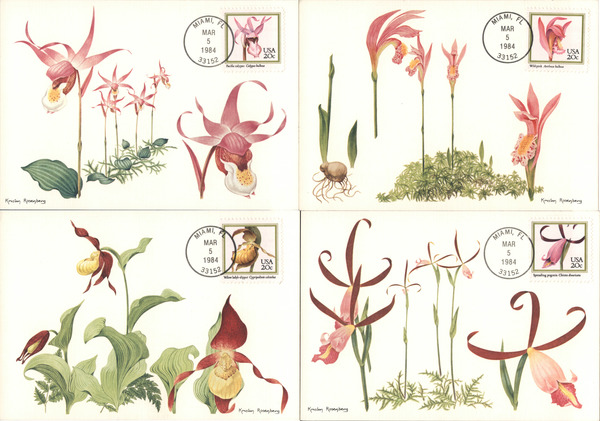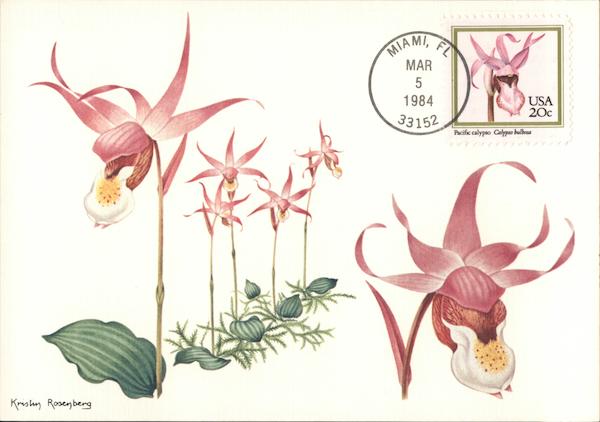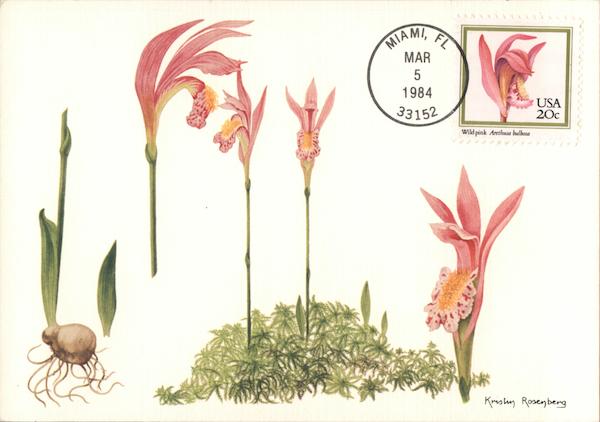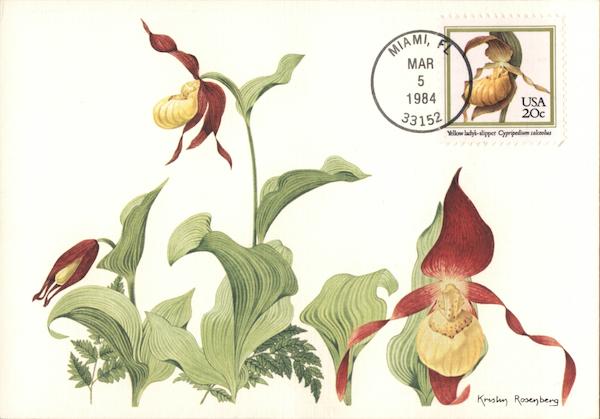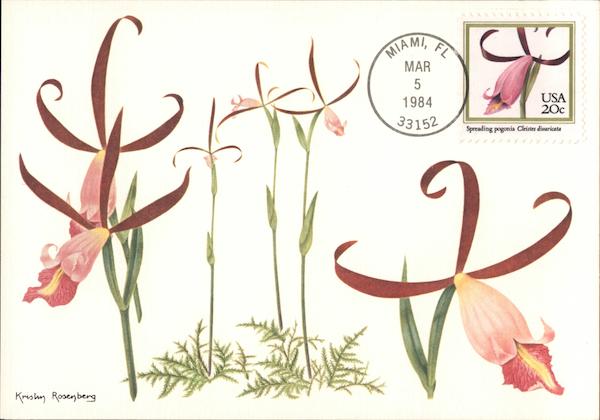Set of 4: 20c Flowers
Front:
FL
MIAMI,
1984
20c
33152
Pacific calypso Calypso bulbosa
Krishin Rosenberg
MIAMI,
FL
1984
20c
33152
Wild pink Arethusa bulbosa
Krishin Rosenberg
MIAMI,
1984
200
33152
Yellow ladys-slipper Cypripedium calceolus
Kristig Rosenberg
FL
MIAMI,
1984
20c
33152
Spreading pogonia Cleistes divaricata
Kristin Rosenberg
Back:
The noted horticulturist, O. O. Nylander, delightfully
described one of the first times he came in contact with
the Pacific Calypso Orchid ... also known as the Fairy
Slipper. In his words ... “An inviting coolness seeped
from the forest as I strolled between the rough corrugated
trunks, and an undisturbed quietude lay over the green
plateau ... Beneath low hanging bows of conifers could
be seen the bearded lips of the Fairy Slipper – the
delicate nymphal orchid which hides in wet bogs in our
eastern states and trails in deep moss of woodland in the
Rocky Mountains. The solitary pastel pink-purple flow-
ers, touched here and there with white and yellow,
diffidently nodded on the tips of short slender stems.
Myriads of these dainty little plants grew in a mossy
cushion in the dense shadow of low horizontal spruce
branches. As if to secrete their beauty for some sylvan
sprite, they had hidden themselves in solitude, for no
other herb kept them company ..." The Pacific Calypso
is indeed a remarkably beautiful flower. In fact, to celeb-
rate this orchid's loveliness, the United States issued the
No. 84-14
©1984 The Maximum Card Collection
A Division of Unicover Corporation . Cheyenne, WY 82008-0007
Original painting by Kristin Rosenberg.
As the devastating Ice Age slowly crept over the world's
continents, a lovely flowering plant ... known today
as the Wild Pink Orchid . . . survived just beyond reach
of the icy cold. Blooming in the warm Carolina Hills,
this orchid awaited the end of the Ice Age and then
quickly expanded throughout the Eastern United States
and Canada. Today, the Wild Pink can be found thriving
in the nurtured protection of sphagnum bogs, wet turfy
meadows, open swamps, and along the fertile flats of
rivers. The lovely orchid has been found as far south as
Louisiana and as far north as Newfoundland and Nova
Scotia. Interestingly, the orchid received its scientific
name – Arethusa — from a mythical river nymph of
classical literature. Regardless of its origins, this lovely
orchid stands today as one of the most breathtakingly
beautiful flowers in existence ... setting high on an
elegant, narrow stock, with its beautifully colored flower
held erect by the rigid scape. To celebrate the dazzling
beauty of the Wild Pink Orchid, the United States Postal
Service issued the stamp that is featured on the front of
this Maximum Card.
--
No. 84-15
©1984 The Maximum Card Collection
A Division of Unicover Corporation . Cheyenne, WY 82008-0007
Original painting by Kristin Rosenberg.
The scientific name for the Lady's Slipper Orchid —
Cypripedium Calceolus — well describes the appearance
of the plant itself. The name, Calceolus, is a Latin noun
meaning "a little shoe," making reference to the orchid's
unusual “shoe-like" shape. Indeed, delicately set atop a
short, leafy stock, the flower of this orchid has the very
appearance of a tiny, velvet-soft slipper. However, the
Lady's Slipper has been known by many other names as
well ... including such titles as Noah's Ark ... Whip-
poorwill-shoe . . . Monkey Flower . ... and Nerve
Root. Yet, this radiant orchid is remarkable in more ways
than by its shape alone. It is also one of the very few
orchids that can be found in North America, Europe and
Asia. In addition, the Lady's Slipper can be observed
growing along warm swampy marshes and bogs near
the ocean ... or as high as 12,000 feet in the thin,
chilly air of the Himalaya Mountains. The Lady's Slipper
orchid is indeed a remarkable plant. In fact, the United
States Postal Service issued the colorful postage stamp
that is affixed to the front of this Maximum Card to honor
this lovely orchid.
No. 84-16
©1984 The Maximum Card Collection
A Division of Unicover Corporation . Cheyenne, WY 82008-0007
Original painting by Kristin Rosenberg.
Atop long, slender stems ... accented with delicate
green leaves, sprouting skyward . . . are the softly col-
ored petals of the Spreading Pogonia Orchid. The deli-
cate coloration of its flower makes this plant one of the
most attractive orchids of North America. Usually light
pink in color, this lovely orchid has also been known
by such names as the Rosebud Orchid ... Funnel-
crest ... and Ladies' Ettercap. Unlike many orchids, the
Spreading Pogonia is very versatile and can easily survive
in many different types of habitats. Most often found in
low, moist, grassy pine barrens, this remarkable orchid
can also be found growing on exposed mountain slopes.
Interestingly, the Spreading Pogonia seems to thrive in
soil that is intensely acidic ... a condition that would
quickly wither most other orchids. Geographically, this
orchid can be found growing from near sea level on the
Atlantic Coastal Plain and Gulf Coast ... all the way
up to four thousand feet altitude in the lush mountains
of North Carolina and Tennessee. To honor the beauty
of this American orchid, the United States issued the
No. 84-17
©1984 The Maximum Card Collection
A Division of Unicover Corporation . Cheyenne, WY 82008-0007
Original painting by Kristin Rosenberg,


